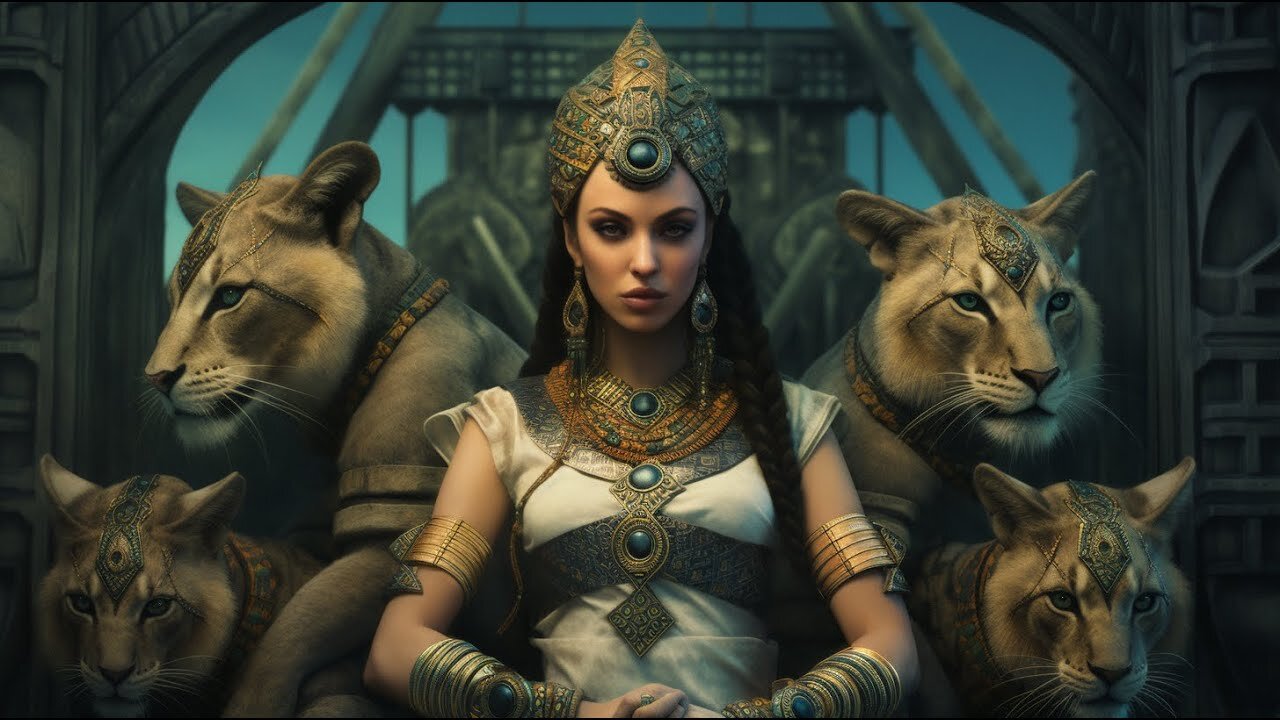Premium Only Content

The Hidden Mysteries: Esoteric Symbolism & Divine Secrets in Egyptian Temple Art & Architecture
The Hidden Mysteries: Esoteric Symbolism & Divine Secrets in Egyptian Temple Art & Architecture
-
32,867 views Streamed live June 7, 2023
Boaz Mysteries
***
The Cosmology, or Origins of the Egyptian gods does indeed sound FREAKY. One might say Sacred and Profane. But the masses were not allowed to know the Profound Truth that were held Secret by the Initiates of the Elite Priesthoods. The Priest understood the gods to represent Spiritual Truths, Symbolic of Higher Reality on the Path of Initiation and Illumination.
-
This knowledge served them well.
-
For the people of Egypt (Kemet) were extremely poise and devout. The Priesthood Hoodwinked the masses through the use of their Secret Occult Knowledge.
-
Their entire world view of the Egyptians was focused and based upon divinity and as a preparation for the afterlife.
-
Thus the Priesthood preyed upon their ignorance and tricked them into paying for the Great Wealth and Power that they attained.
-
By claiming that they all served at the will of the gods and the Pharaoh god king, they created a true system of Masters and Slaves.
-
THUS IT HAS BEEN, SINCE THE BEGINNING OF RECORDED TIME
-
Many sources claim that the Egyptians were the Inheritors of the Atlantean Priest Kings who were also corrupt and used their Power over the masses and used their Secret Knowledge to battle for Power among themselves.
-
The Time of Zep Tepi when the gods (Anunnaki) themselves ruled was of a completely different nature, that was long lost to history even in the Pre-Dynastic era.
-
@OratorBlog 10-11-2023
*********
32,867 views Streamed live on Jun 7, 2023 UNRAVELLING ANCIENT EGYPT PODCAST, Ancient Origins, Lost Knowledge, Weird History
Egyptian mythology played a central role in shaping the religious beliefs, cultural practices, and artistic expressions of ancient Egypt. The temples, with their intricate architecture and elaborate artwork, served as sacred spaces dedicated to the veneration of deities and the rituals associated with them.
-
This analysis will delve into the details of how Egyptian mythology was implemented in temple art and architecture, exploring the key elements, symbolism, and the overall significance of these artistic representations. Divine Iconography: a. Deity Representations: Egyptian temples prominently featured statues, reliefs, and paintings depicting various deities.
-
The gods and goddesses were depicted in human or animal form, often blending human bodies with animal heads or other animalistic features. Each deity had distinct iconography and symbolic attributes associated with their roles and domains. For example, the falcon-headed Horus symbolized kingship and protection, while the cat-headed Bastet represented fertility and domesticity. b. Symbolic Pose and Gestures: The deities were often portrayed in specific poses and gestures that conveyed their attributes and roles. For instance, Osiris, the god of the afterlife, was depicted as a mummified figure with crossed arms, symbolizing resurrection and eternal life. The goddess Maat, associated with truth and justice, was represented with an ostrich feather on her head, symbolizing balance and harmony.
-
Mythological Narratives: a. Creation Stories: Egyptian temples incorporated mythological narratives, particularly creation stories, in their artwork. These narratives depicted the origins of the world and the divine beings responsible for its creation.
-
The most famous creation myth involved the god Atum, who emerged from the primeval waters and created the cosmos through his divine will and actions. b. Divine Epics and Cycles: Temples also showcased epic tales and mythological cycles that recounted the adventures, conflicts, and triumphs of various gods and goddesses. These narratives often depicted battles between deities, the journeys of the sun god Ra, and the triumph of Horus over the chaotic forces of Seth. These stories served to reinforce the cosmic order and the struggle between good and evil.
-
Symbolism and Rituals: a. Sacred Symbols: Temple architecture and artwork incorporated a plethora of symbolic elements. These symbols carried deep religious and mythological meanings. For instance, the ankh symbol represented life and was often associated with the goddess Isis. The scarab beetle symbolized rebirth and was linked to the sun god Khepri. These symbols were incorporated into temple decorations, offering a visual language that the worshippers could understand and relate to. b. Ritualistic Depictions: Temple art depicted religious rituals and ceremonies, showcasing priests engaging in offerings, purification rituals, and sacred processions.
-
These artistic representations aimed to convey the important role of the priesthood in maintaining divine order and appeasing the gods through ritualistic practices. Cosmic Alignment: a. Sacred Geometry: Egyptian temple architecture followed precise geometric principles, reflecting the cosmological beliefs of the ancient Egyptians.
-
Temples were constructed with meticulous alignments to celestial bodies and cardinal directions, symbolizing the connection between the divine realm and earthly existence. The axis of the temple often pointed towards the rising sun or aligned with specific stars, emphasizing the cosmic order and the divine presence. b. Hypostyle Halls and Sacred Spaces: Temple architecture included hypostyle halls, characterized by rows of towering columns. These halls served as spaces for communal worship and rituals. The columns, adorned with intricate carvings and hieroglyphics, showcased mythological scenes and divine figures, immersing the worshippers in the mythic world and creating a sense of awe and reverence.
-
Egyptian mythology permeated every aspect of temple art and architecture, serving as a visual representation of the complex religious beliefs and rituals of ancient Egypt. From divine iconography and mythological narratives to symbolic elements and cosmic alignments, the temples became immersive spaces that bridged the earthly and divine realms, fostering a deep sense of spirituality and reverence for the gods. Through these artistic expressions, Egyptian mythology became an integral part of the cultural fabric and collective consciousness of the ancient Egyptian
-
FAIR USE FOR EDUCATIONAL PURPOSES
-
Mirrored From:
https://www.youtube.com/@BoazMysteries
-
 29:53
29:53
MYLUNCHBREAK CHANNEL PAGE
1 day agoUnder The Necropolis - Pt 1
72.9K42 -
 2:00:10
2:00:10
Bare Knuckle Fighting Championship
3 days agoCountdown to BKFC on DAZN HOLLYWOOD & FREE LIVE FIGHTS!
36K3 -
 2:53:01
2:53:01
Jewels Jones Live ®
1 day agoA MAGA-NIFICENT YEAR | A Political Rendezvous - Ep. 103
71.4K21 -
 29:54
29:54
Michael Franzese
10 hours agoCan Trump accomplish everything he promised? Piers Morgan Article Breakdown
87.6K48 -
 2:08:19
2:08:19
Tactical Advisor
14 hours agoThe Vault Room Podcast 006 | Farwell 2024 New Plans for 2025
166K11 -
 34:12
34:12
inspirePlay
1 day ago $4.94 earned🏆 The Grid Championship 2024 – Cass Meyer vs. Kelly Rudney | Epic Battle for Long Drive Glory!
71K8 -
 17:50
17:50
BlackDiamondGunsandGear
11 hours ago $1.70 earnedTeach Me How to Build an AR-15
46.1K6 -
 9:11
9:11
Space Ice
1 day agoFatman - Greatest Santa Claus Fighting Hitmen Movie Of Mel Gibson's Career - Best Movie Ever
107K45 -
 42:38
42:38
Brewzle
1 day agoI Spent Too Much Money Bourbon Hunting In Kentucky
71.3K12 -
 1:15:30
1:15:30
World Nomac
20 hours agoMY FIRST DAY BACK in Manila Philippines 🇵🇭
54.6K9